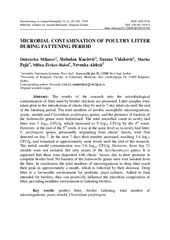Приказ основних података о документу
Microbial contamination of poultry litter during fattening period
Mikrobiološka kontaminacija prostirke tokom tova brojlera
| dc.creator | Milanov, Dubravka | |
| dc.creator | Knežević, Slobodan | |
| dc.creator | Vidaković, Suzana | |
| dc.creator | Pajić, Marko | |
| dc.creator | Živkov-Baloš, Milica | |
| dc.creator | Aleksić, Nevenka | |
| dc.date.accessioned | 2020-06-03T14:31:08Z | |
| dc.date.available | 2020-06-03T14:31:08Z | |
| dc.date.issued | 2019 | |
| dc.identifier.issn | 1450-9156 | |
| dc.identifier.uri | https://vet-erinar.vet.bg.ac.rs/handle/123456789/1706 | |
| dc.description.abstract | The results of the research into the microbiological contamination of litter used by broiler chickens are presented. Litter samples were taken prior to the introduction of chicks (day 0) and in 7-day intervals until the end of the fattening period. The total numbers of aerobic mesophilic microorganisms, yeasts, moulds and Clostridium perfringens spores, and the presence of bacteria of the Salmonella genus were determined. The total microbial count in newly laid litter was 7 log10 CFU/g, which increased to 9 log10 CFU/g by the 4th week. However, at the end of the 5th week, it was at the same level as in newly laid litter. C. perfringens spores, presumably originating from chicks' faeces, were first detected on day 7. In the next 7 days their number increased, reaching 3-4 log10 CFU/g, and remained at approximately same levels until the end of the research. The initial mould contamination was 5-6 log10 CFU/g. However, from day 21 moulds were not isolated, but only yeasts of the Saccharomyces genus. It is supposed that these were deposited with chicks' faeces, due to their presence in complete broiler feed. No bacteria of the Salmonella genus were ever isolated from the litter. In conclusion, the total numbers of microorganisms in deep litter reach their peak in approximately a month, which is followed by their decrease. Deep litter is a favourable environment for probiotic yeast cultures. Added to feed intended for broilers, they can positively influence the microbial composition of litter, providing healthier environment to fattening broilers. | en |
| dc.description.abstract | U radu su prikazani rezultati ispitivanja mikrobiološke kontaminacije prostirke korišćene u tovu pilića. Prostirka je uzorkovana pre naseljavanja objekata i u nedeljnim intervalima tokom 35 dana tova pilića. Uzorci su ispitani na ukupan broj aerobnih mezofilnih mikroorganizama, kvasaca, plesni i spora Clostridium perfringens, kao i prisustvo bakterija roda Salmonella. Ukupan broj mikroorganizama u svežoj prostirci iznosio je 7 log10 CFU/g, a do 4 nedelje tova pilića povećao se do 9 log10 CFU/g. Međutim, na kraju pete nedelje tova, ukupan broj mikroorganizama u prostirci bio je na nivou vrednosti ustanovljenih u svežoj prostirci. Spore C. perfringens su ustanovljene tek sedmog dana od naseljavanja objekta, što ukazuje da u prostirku dospevaju fecesom pilića. Za 14 dana broj spora C. perfringens se povećao do 3-4 log10 CFU/g i na približno istim vrednostima zadržao do kraja ispitivanja. Sveža prostirka bila je kontaminirana plesnima u nivou od 5-6 log10 CFU/g, ali od 21. dana iz uzoraka prostirke nisu izolovane plesni, već samo kvasci roda Saccharomyces. Pretpostavka je da su kvasci u prostirku dospeli fecesom pilića, jer se koriste kao probiotske kulture u smešama za njihov tov. Bakterije roda Salmonella nisu izolovane iz prostirke. Rezultati ispitivanja pokazuju da ukupan broj mikroorganizama u prostirci dostiže svoj pik za oko mesec dana, nakon čega se smanjuje. Prostirka je pogodna sredina za život probiotskih kultura kvasaca i njihovo dodavanje u smeše za tov brojlera može imati povoljan uticaj na sastav mikroorganizama u prostirci, a time i obezbeđenje zdravije životne sredine u podnom sistemu uzgoja brojlera. | sr |
| dc.publisher | Institut za stočarstvo, Beograd | |
| dc.relation | info:eu-repo/grantAgreement/MESTD/Technological Development (TD or TR)/31071/RS// | |
| dc.relation | info:eu-repo/grantAgreement/MESTD/Integrated and Interdisciplinary Research (IIR or III)/46002/RS// | |
| dc.rights | openAccess | |
| dc.rights.uri | https://creativecommons.org/licenses/by/4.0/ | |
| dc.source | Biotechnology in Animal Husbandry | |
| dc.subject | poultry litter | en |
| dc.subject | broiler fattening | en |
| dc.subject | total number of microorganisms | en |
| dc.subject | yeast | en |
| dc.subject | mould | en |
| dc.subject | Clostridium perfringens | en |
| dc.subject | prostirka za piliće | sr |
| dc.subject | tovni pilići | sr |
| dc.subject | ukupan broj mikroorganizama | sr |
| dc.subject | kvasci | sr |
| dc.subject | plesni | sr |
| dc.subject | Clostridium perfringens | sr |
| dc.title | Microbial contamination of poultry litter during fattening period | en |
| dc.title | Mikrobiološka kontaminacija prostirke tokom tova brojlera | sr |
| dc.type | article | |
| dc.rights.license | BY | |
| dcterms.abstract | Миланов, Дубравка; Кнежевић, Слободан; Пајић, Марко; Живков-Балош, Милица; Видаковић, Сузана; Aлексић, Невенка; Микробиолошка контаминација простирке током това бројлера; Микробиолошка контаминација простирке током това бројлера; | |
| dc.citation.volume | 35 | |
| dc.citation.issue | 3 | |
| dc.citation.spage | 253 | |
| dc.citation.epage | 265 | |
| dc.citation.other | 35(3): 253-265 | |
| dc.citation.rank | M24 | |
| dc.identifier.doi | 10.2298/BAH1903253M | |
| dc.identifier.fulltext | https://vet-erinar.vet.bg.ac.rs/bitstream/id/665/1705.pdf | |
| dc.type.version | publishedVersion |

